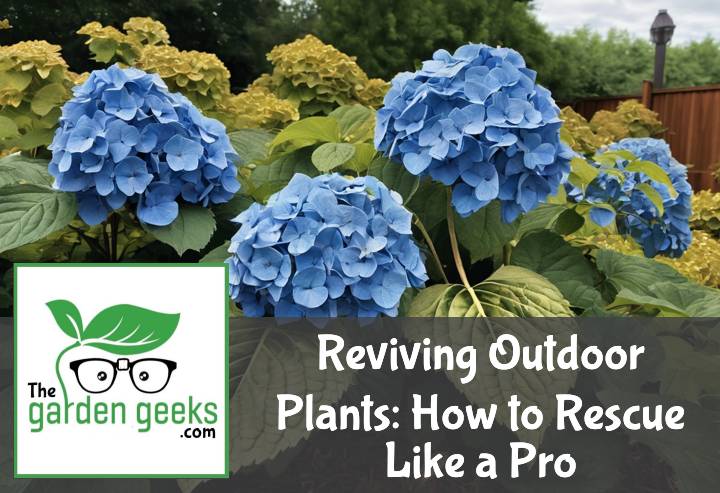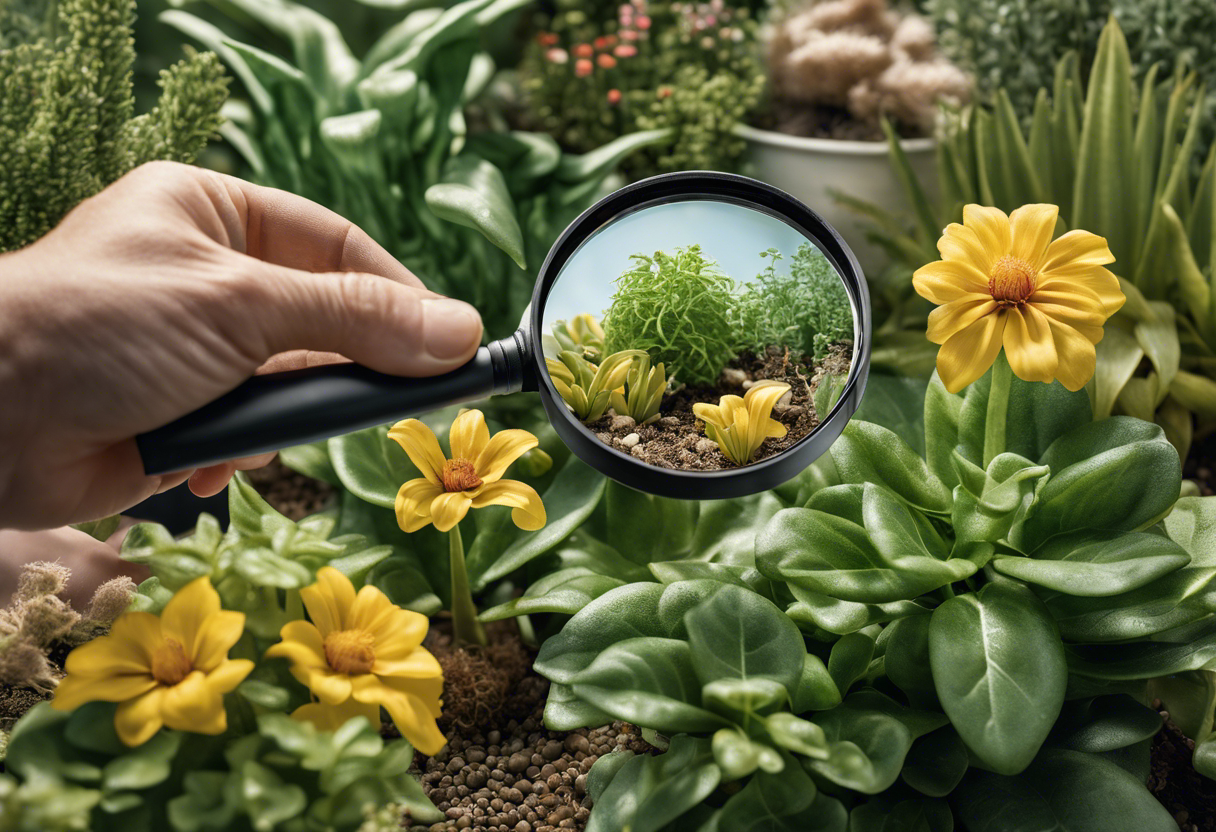Ever found yourself staring at your wilting garden, feeling like a plant doctor with no clue about the cure? Been there, done that! I’ve spent countless hours fretting over my once vibrant green babies, wondering how to bring them back to life. If you’re here, chances are you’re in the same boat. But hey, don’t worry! Reviving Outdoor Plants is not as hard as it seems.
Now let’s cut to the chase and get our hands dirty (quite literally!). We’ll walk through everything from identifying a dying plant to nursing it back to health. So buckle up folks – we’re about to become plant rescuers! “Keep reading about Reviving Outdoor Plants: How to Rescue Like a Pro!”
Key Takeaways
- Identify signs of plant distress such as yellowing leaves, wilting, or slow growth.
- Correct watering issues: Overwatering can lead to root rot while underwatering causes dehydration.
- Improve soil conditions by adding compost or fertilizer for nutrient deficiency.
- Prune damaged parts to prevent disease spread and promote new growth.
- Relocate plants if they’re not getting appropriate light or temperature conditions.
- Seek professional help for severe cases like pest infestation or disease outbreak.
Why Do Outdoor Plants Need Reviving?
Outdoor plants, unlike their indoor counterparts, face a myriad of challenges. From harsh weather conditions to pesky insects and diseases, these factors can significantly impact outdoor plant care. Consequently, there’s often a need for reviving wilted plants as part of regular garden maintenance. Let’s delve into some common plant health issues and how they necessitate the process of restoring plant vitality.
The Impact of Weather Conditions
Mother Nature can be quite unpredictable! Extreme weather conditions like scorching heat or freezing cold can wreak havoc on your green buddies. The weather impact on plants is often underestimated but it plays a significant role in their overall health.
Droughts can lead to wilting as the plants struggle to get enough water. On the other hand, frost can cause damage to plant tissues leading to browning or even death in severe cases. So, understanding the effects of these extreme weathers – both drought effects on plants and frost damage to plants, is crucial in maintaining a healthy garden.
The Role of Pests and Diseases
Then we have those uninvited guests – pests! They love munching on your precious greens causing all sorts of plant pests problems. From aphids sucking out plant juices to caterpillars nibbling away leaves, pests can severely affect plant health.
But that’s not all! Your outdoor space could also be a breeding ground for various diseases. Fungal infections, bacterial blights – you name it! These common garden diseases are another reason why your plants might need reviving. Hence, effective strategies for both pest control and disease prevention are essential elements of successful gardening.
Understanding Plant Stress Factors
Finally, let’s talk about stress – nope not yours but your plants’! Yes, just like us humans, our leafy friends can also experience stress. Plant stress symptoms can range from yellowing leaves to stunted growth.
The causes? Well, they’re plenty! Overwatering, underwatering, poor soil quality, inadequate sunlight – all these are potential causes of plant stress. And when your plants are stressed out, they become more susceptible to diseases and pests.
So there you have it folks! Understanding and managing these plant stressors is key in maintaining a healthy garden and improving stressed plants’ health. Remember, the goal here is not just survival but thriving! So let’s get down to the nitty-gritty of reviving outdoor plants, shall we?
How to Identify a Dying Outdoor Plant?
Identifying dying plants is a bit like playing detective. You’ve got to know what you’re looking for and catch the signs early. It’s all about outdoor plant health and spotting those telltale signs of plant distress before it’s too late.
Recognizing Signs of Distress in Plants
So, how do you spot these so-called plant distress signs? Well, it’s all in the visuals. Keep an eye out for changes in color, texture, or size. If your plant starts looking different from its usual self, that’s a red flag right there.
But don’t stop at just looks! Pay attention to changes in plant growth too. Is your plant growing slower than usual? Or maybe it’s sprouting new leaves at a rate that would make Jack’s beanstalk jealous? Either way, something might be up.
Common Symptoms of Unhealthy Plants
Now let’s talk symptoms. When it comes to symptoms of unhealthy plants, discoloration is often the first thing you’ll notice. If your once vibrant green friend is now sporting yellow or brown hues, it might be time for some TLC.
And then there’s wilting. Nothing screams “Help me!” quite like a droopy, sad-looking plant. So if your outdoor buddy starts resembling a wilted salad leaf rather than the proud flora it once was, consider this another SOS signal.
When to Seek Professional Help?
Sometimes though, despite our best efforts, we need to call in the pros. If your attempts at reviving dying plants aren’t working or if the situation seems beyond your control, don’t hesitate to seek professional help.
Plant care services can diagnose issues more accurately and provide targeted treatments that can work wonders on your struggling green friends. Remember folks – there’s no shame in asking for help when it comes to reviving outdoor plants. After all, we’re all in this for the love of our leafy pals!
What Tools and Materials are Needed for Reviving Plants?
When it comes to reviving outdoor plants, having the right tools and materials can make a world of difference. We’re talking about gardening tools, fertilizers, soil amendments, and watering equipment – all the good stuff that makes your green thumb even greener.
Essential Gardening Tools
First things first, let’s talk about essential gardening tools. You’ll need your trusty pruning shears for plant revival. These bad boys help you trim away dead or diseased parts of the plant. Next up is the garden trowel. This handy tool is perfect for digging small holes or moving small amounts of dirt around.
Don’t forget your hand gloves! They protect your hands from thorns, splinters, and any creepy crawlies lurking in the soil. Last but not least, we’ve got spades – these essential spades in gardening are great for breaking up hard soil or making larger holes.
Choosing the Right Fertilizers and Soil Amendments
Moving on to fertilizers and soil amendments. The right fertilizer can be like a magic potion for your plants. Opting for organic fertilizers for plant revival can provide nutrients without harming the environment.
Soil amendments also play a big role in reviving plants effectively. They improve the physical properties of soil like structure, porosity, water retention and more. And don’t forget about pH balance! Choosing soils with the correct pH balance can help your plants absorb nutrients better.
Importance of Proper Watering Equipment
Last but definitely not least: watering equipment! Having proper watering equipment is crucial when it comes to reviving outdoor plants successfully.
Watering cans might seem old school, but they allow you to control how much water each plant gets – very important if you ask me! Hose nozzles are another great tool; they let you adjust water pressure, so you don’t accidentally wash away your plants.
And let’s not forget about drip irrigation systems. These systems deliver water directly to the roots of your plants, which can be a game-changer in plant revival. So there you have it – the right tools and materials can make all the difference when reviving your outdoor plants!
How to Revive Different Types of Outdoor Plants?
When it comes to reviving outdoor plants, the approach can vary. Whether you’re dealing with flowering plants, a vegetable or herb garden, or trees and shrubs, each requires a unique touch.
Rescuing Flowering Plants
So your flowers are looking a bit under the weather? Fear not! Flowering plant rescue is possible. The first step in reviving wilted flowers is to ensure they’re getting enough water. But remember, too much love (or water) can be just as harmful.
Next up, check for signs of pests or disease. If you spot any creepy crawlies or funky fungi, it’s time for some pest control action. Lastly, consider whether your flowers might be in need of a little extra nutrition. Sometimes all it takes is a good feed to bring those blooms back from the brink!
Saving Vegetable and Herb Gardens
If your veggie patch or herb garden is struggling, don’t despair! With the right care and attention, you can turn things around. Start by assessing your watering habits – are you giving them too much H2O, or perhaps not enough?
Next on the agenda is soil health. Consider adding some organic matter like compost or well-rotted manure to improve soil structure and nutrient content. And let’s not forget about those pesky pests! A little natural pest control could be just what your garden needs.
Revitalizing Trees and Shrubs
Trees and shrubs can often bounce back with a bit of TLC. Pruning is an essential part of tree health restoration – removing dead or diseased branches allows the tree to focus its energy on new growth.
But don’t go snip-happy! Over-pruning can cause stress and lead to further decline. And if your shrubs are looking lackluster despite proper pruning, they might benefit from some nutrient supplementation. A slow-release fertilizer can work wonders for shrub health restoration.
Remember, reviving outdoor plants is a labor of love – but the rewards are well worth the effort!
What are the Best Practices for Plant Care Post-Revival?
After reviving outdoor plants, it’s crucial to follow a few best practices. This includes regular monitoring, seasonal care, and preventive measures. These steps ensure your green friends stay healthy and avoid future damage.
Regular Monitoring and Maintenance
Regular monitoring is like a daily check-up for your plants. It helps you spot any signs of trouble early on. For instance, wilting leaves might mean they’re thirsty, so adjust your watering schedule for plants accordingly.
Pruning is another part of maintaining outdoor plants. By snipping off dead or diseased parts, you help the plant focus its energy on new growth. Remember, a little TLC goes a long way in your garden maintenance routine!
Seasonal Care for Outdoor Plants
Each season brings its own set of challenges and opportunities for our leafy pals. In summer, they might need extra water to beat the heat. So ramp up your summer plant care game by watering them more frequently.
Winter can be harsh too with frost being a common enemy. Protecting them with mulch or cloth wraps can be part of your winter plant protection strategy.
Spring is all about growth! Use this time to fertilize and prune as needed – just some handy spring gardening tips for you there!
Autumn? It’s prep time! Clear fallen leaves and start preparing beds for next year’s planting – that’s how you ace your autumn garden preparation!
Preventive Measures Against Future Damage
Prevention is always better than cure, especially when it comes to plant health. Keep an eye out for pests – they can wreak havoc if left unchecked! A good pest control strategy should be part of protecting revived plants.
Also, rotate crops if possible to prevent soil depletion and disease spread – just one of many useful garden disease prevention tips.
And finally, don’t forget to mulch! It not only keeps the soil moist but also prevents weed growth. Now that’s what I call a win-win in preventing plant damage!
To Wrap Up
Just like a superhero swooping in to save the day, you now have the power to breathe life back into your wilting garden! Remember, Reviving Outdoor Plants is a bit like running an emergency room for greenery – it’s all about quick diagnosis and timely care!
So, go on! Put on your cape, grab your watering can and let’s make our gardens great again!





